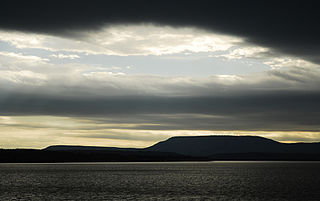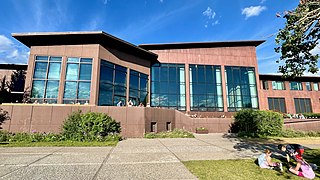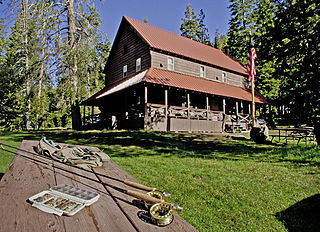
Lake Lawn Resort is a resort in Delavan, Wisconsin, United States located on the shores on Delavan Lake. It is located off Highway 50, near Interstate 43. Lake Lawn has its own private airport, Lake Lawn Airport.

The Lake McDonald Lodge is a historic lodge located within Glacier National Park, on the southeast shore of Lake McDonald. The lodge is a 3+1⁄2-story structure built in 1913 based on Kirtland Cutter's design. The foundation and first floor walls are built of stone, with a wood-frame superstructure. The lobby is a large, open space that extends to the third story. It has a massive fireplace and a concrete floor scored in a flagstone pattern, with messages in several Indian languages inscribed into it. The rustic lodge was designated a National Historic Landmark in 1987 as one of the nation's finest examples of large-scale Swiss chalet architecture. Lake McDonald Lodge is a member of Historic Hotels of America, the official program of the National Trust for Historic Preservation.

Located near Dardanelle, Arkansas and rising 1,350 feet (410 m) above the mountain valleys of west central Arkansas, Mount Nebo has a view of 34,000 acres (140 km2) Lake Dardanelle, the Arkansas River and the surrounding mountain ridges. Atop this biblically named plateau, fringed by the Ouachita National Forest, is Mount Nebo State Park. Developed as a resort area in the late 19th century, it became a state park in 1928, its early development spearheaded by the Civilian Conservation Corps. Park activities include hiking, camping, and other outdoor pursuits.

The Snake River Ranch, near Wilson, Wyoming, is the largest deeded ranch in the Jackson Hole area. The ranch buildings are grouped into three complexes comprising headquarters, residential and shop complexes. The ranch combined two neighboring homesteads and was first owned by advertising executive Stanley B. Resor and his wife, Helen Lansdowne Resor. The Resors used the property as a vacation home, but the ranch was also a full-time, self-sustaining operation.

Jackson Lake Lodge is located near Moran in Grand Teton National Park, in the U.S. state of Wyoming. The lodge has 385 rooms, a restaurant, conference rooms, and offers numerous recreational opportunities. The lodge is owned by the National Park Service, and operated under contract by the Grand Teton Lodge Company. The Grand Teton Lodge Company also manages the Jenny Lake Lodge, as well as cabins, restaurants and other services at Colter Bay Village. The lodge is located east of Jackson Lake adjacent to prime moose habitat below the Jackson Lake Dam.

Drakesbad Guest Ranch, also known simply as Drakesbad, is a resort near Chester, California. It is located on Hot Springs Creek at the head of Warner Valley, in Lassen Volcanic National Park.

The Murie Ranch Historic District, also known as the STS Dude Ranch and Stella Woodbury Summer Home is an inholding in Grand Teton National Park near Moose, Wyoming. The district is chiefly significant for its association with the conservationists Olaus Murie, his wife Margaret (Mardy) Murie and scientist Adolph Murie and his wife Louise. Olaus and Adolph Murie were influential in the establishment of an ecological approach to wildlife management, while Mardy Murie was influential because of her huge conservation victories such as passing the Alaska National Interest Lands Conservation Act of 1980 and being awarded with the highest civilian honor, the Presidential Medal of Freedom, for her lifetime works in conservation. Olaus Murie was a prominent early field biologist in the U.S. Biological Survey and subsequent U.S. Fish and Wildlife Service before retiring and becoming the president of the Wilderness Society, He was a prominent advocate for the preservation of wild lands in America.

Pahaska Tepee is William "Buffalo Bill" Cody's old hunting lodge and hotel in the U.S. state of Wyoming. It is located 50 miles (80 km) west of the town of Cody and two miles from the east entrance to Yellowstone National Park.

The Dearborn Inn, A Marriott Hotel, is a luxurious historic hotel, conceived by Henry Ford, who saw a need for food and accommodations for visitors flying into the nearby Ford Airport, making it one of the first airport hotels. It is located in Metro Detroit at 20301 Oakwood Boulevard in the suburban city of Dearborn, Michigan near The Henry Ford and the world headquarters building of Ford Motor Company. Albert Kahn designed the Dearborn Inn in the Georgian architectural style. The Dearborn Inn is owned by Ford Motor Land Development Corporation and managed by Marriott International.

The Redick Lodge, also known as the Chambers Lodge, is a private seasonal retreat on Upper Fremont Lake near Pinedale, Wyoming in the Wind River Range at an elevation of 7,500 feet (2,300 m). The lodge was designed by architect Otis Miller of Miles City, Montana as a log cabin on a stone foundation for George M. Redick, a Nebraskan who had worked with the Union Pacific Railroad on potential locations for company hotels. The Redick family spent summers at the lodge from 1918 through 1931, when family fortunes declined. The property was purchased by Dr. Oliver Chambers of Rock Springs, Wyoming in 1938 and has remained in the Chambers family.

Flat Creek Ranch, formerly a working ranch in Jackson Hole, Wyoming, is a guest ranch. The original ranch was established by Cal Carrington between 1901 and 1918 at the base of Sheep Mountain, also known as the ″Sleeping Indian″. In 1923 a new owner, socialite and journalist Cissy Patterson, built the present structures. The transition from working ranch to vacation retreat foreshadowed a movement of the Jackson Hole economy away from traditional ranching to tourism, which is documented by the Flat Creek Ranch.

The White Grass Dude Ranch is located in the White Grass Valley of Grand Teton National Park. The rustic log lodge, dining hall service building and ten cabins were built when a working ranch was converted to a dude ranch, and represented one of the first dude ranch operations in Jackson Hole. The White Grass was established in 1913 by Harold Hammond and George Tucker Bispham, who combined two adjacent ranches or 160 acres (65 ha) each, and was converted to a dude ranch in 1919. Bispham had worked at the Bar B C before moving out on his own. The dude ranch operation continued to 1985, when the ranch was acquired by the National Park Service.

The Red Star Lodge and Sawmill, also known as the Shoshone Lodge, is a dude ranch in Shoshone National Forest near the east entrance to Yellowstone National Park. Built between 1924 and 1950, the ranch includes a rustic log lodge surrounded by cabins and support buildings. What is now called the Shoshone Lodge is the most intact example of a dude ranch operation in the area.

The Masonic Temple in downtown Casper, Wyoming is a Masonic hall, built in 1914 during a boom time initiated by the development of the Salt Creek Oil Field. Located on a corner site, the temple remains essentially as it was designed by Casper architect Homer F. Shaffer. The four story light-colored brick building rests on a raised basement and is topped by a crenelated parapet. The original windows have been replaced with vinyl units but retain the one-over-one appearance of the originals. Windows extend over the west and south sides. The north side is blank, while the east side is the building's rear facade and has fire escapes and a few windows.

Will Rogers Memorial Hospital is a historic tuberculosis sanatorium located at Saranac Lake in Essex County, New York. It was built in 1928 as the National Vaudeville lodge by the National Vaudeville Artists Association, who previously sent patients to the Kennedy Cottage. It is a three-story, "T" shaped, steel frame and reinforced concrete structure above a raised basement. It is faced in stucco and decorative half-timber framing in the Tudor Revival style. It features asymmetrical massing, a three-story polygonal tower with a hexagonal roof, and three story pavilions with recessed sleeping porches. It was named in honor of entertainer Will Rogers (1879-1935) in 1936 and provided unconventional tubercular treatment to entertainment industry patients from 1936 to 1975. It also was open as a night club but when casinos were voted down in New York, it was closed. Then it was open as an apartment house. It stood abandoned for years slowly deteriorating. It was briefly used as press headquarters for the 1980 Winter Olympics. Finally it was bought and after a huge renovation was done both to the outside and inside, it currently houses an independent living facility known as Saranac Village at Will Rogers.

The historical buildings and structures of Grand Teton National Park include a variety of buildings and built remains that pre-date the establishment of Grand Teton National Park, together with facilities built by the National Park Service to serve park visitors. Many of these places and structures have been placed on the National Register of Historic Places. The pre-Park Service structures include homestead cabins from the earliest settlement of Jackson Hole, working ranches that once covered the valley floor, and dude ranches or guest ranches that catered to the tourist trade that grew up in the 1920s and 1930s, before the park was expanded to encompass nearly all of Jackson Hole. Many of these were incorporated into the park to serve as Park Service personnel housing, or were razed to restore the landscape to a natural appearance. Others continued to function as inholdings under a life estate in which their former owners could continue to use and occupy the property until their death. Other buildings, built in the mountains after the initial establishment of the park in 1929, or in the valley after the park was expanded in 1950, were built by the Park Service to serve park visitors, frequently employing the National Park Service Rustic style of design.

Cambria (1889-1928) is a ghost town located in the Black Hills of Weston County, Wyoming, United States. It was a successful coal mining town for decades.

The Briarcliff Lodge was a luxury resort in the village of Briarcliff Manor, New York. It was a notable example of Tudor Revival architecture, and was one of the largest wooden structures in the United States. It was also the first hotel in Westchester County. Walter William Law had it built on his estate, and the Law family owned it until 1937. When the lodge opened in 1902, it was one of the largest resort hotels in the world. The lodge hosted presidents, royalty, and celebrities, and was the scene of numerous memorable occasions for visitors and local residents who attended weddings, receptions, and dances in the ballroom and dining room. For a long time, the lodge was situated among other businesses of Walter Law, including the Briarcliff Farms and Briarcliff Table Water Company.

The Brooks Lake Lodge, also known as the Brooks Lake Hotel and Diamond G Ranch, as well as the Two-Gwo-Tee Inn, is a recreational retreat in Fremont County, Wyoming near Dubois in the upper Wind River valley. The complex was built in 1922 to accommodate travelers coming to Yellowstone National Park on U.S. Route 287 from central Wyoming. The buildings are mainly of log construction with Craftsman style detailing.

Casa del Rey Hotel was a resort hotel in Santa Cruz, California. During World War II the hotel was converted to the Naval Convalescent Hospital, Santa Cruz. The hotel was built in 1911 by Fred Swanton on Beach Street as a Santa Cruz Boardwalk development plan. The Resort Hotel had: a pool; gardens; and a grand pedestrian bridge to cross the street to visit the beach. The hotel was at about 500 Beach Street and Cliff Street. In addition to the hotel, there were built Cottage apartments. Later after the war the hotel became a senior citizen housing. In the 1989 Loma Prieta earthquake there was serious damage to the hotel and was taken down. The site now is the parking lot across the street from the Santa Cruz Beach Boardwalk amusement park.

















